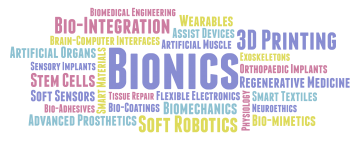Bionics Network
Background
History
Bionics Network

The Bionics Network is a Research Excellence Cluster at the University of British Columbia, supported by the Vice President, Research & Innovation (VPRI) Office and the Institute for Computing, Information, and Cognitive Systems (ICICS).
The Bionics Network brings experts in engineering and biomedical areas together with end users to develop the next generation of materials and devices that can be integrated safely long-term with the body. Experts range in field from device engineering, materials design and signal processing, to surgery, biomonitoring and tissue engineering. The goal of the Bionics Network is to advance the field towards the commercialization of safe, user-friendly materials and technology that improve health and well-being by performing preventative, restorative and assistive functions. In addition, the network seeks a better understanding of how artificial materials and human tissue can be combined to form stable biohybrid systems. The network is actively engaged in developing local, national and international collaborations that support this work.
Bionics Background

The term “bionics”, coined in 1958 by Jack E. Steele, represents the interface between technology and biology. This area of interdisciplinary research is one of growing interest for the general public, industry and researchers. Advances in preventative, restorative and assistive healthcare technologies depend on our ability to create seamless integration between humans and artificial materials.
Key innovations at the forefront of this research include smart hydrogels for tissue engineering scaffolds, soft electronics for brain-machine interfaces, and a general movement towards biohybrid systems. Some major applications include development of materials and devices towards wearable health monitors, surgical implants, prosthetics and orthotics, mobility aids and rehabilitation. As the field evolves, close collaboration between scientists, engineers, clinicians and patients will lead to a new class of mixed natural-artificial systems. The Bionics Network develops materials, technologies and partnerships that support this diverse and exciting field.
History of Bionics Network
British Columbia has long been a bionics hub in Canada, nurturing a base of interest and research and developments bridging technology and biology to improve people’s lives for many years. This has led to the logical birth at the University of British Columbia of the Bionics Network. Here we list some of the key events that have led to the establishment of our collaborative effort.
1980
Terry Fox of Port Coquitlam, British Columbia, undertakes the Marathon of Hope with the goal to run across Canada with the assistance of a prosthetic leg to raise money for cancer research. Sadly he passes away from cancer the next year, but his campaign raises $23 million for cancer research.
1985
Rick Hansen, a British Columbian who was paralyzed in a car accident, sets out on the Man in Motion world tour, a 34 country, 40 000 km wheelchair trip around the world, raising $26 million for SCI research, rehabilitation and sport.
1988
The Man in Motion World Tour Society (later the Rick Hansen Foundation) is created based in Vancouver, British Columbia, to raise money to support research for and improve lives of people with spinal cord injury.
1995
Collaboration on Repair Discoveries- CORD is founded with support of Rick Hansen and UBC. The first Rick Hansen Man-in-Motion Chair in Spinal Cord Research is named Dr. Wolfram Tetzlaff.
2002
CORD’s vision expands and is renamed ICORD (for international), and is awarded a Canada Foundation for Innovation infrastructure award of $12.8M.
2008
Rick and the Rick Hansen Foundation create the Rick Hansen Institute (now the Praxis Spinal Cord Institute) and help establish the Blusson Spinal Cord Centre in Vancouver, British Columbia, where ICORD makes its new home as a global collaboration of researchers and service providers to promote functional recovery and quality of life following spinal cord injury.
2013
Dr. Wolfram Tetzlaff becomes director of ICORD.
2017
UBC’s School of Biomedical Engineering (SBME) is founded through a partnership between the Faculties of Applied Science and Medicine. Dr. Karen Cheung serves as Associate Director and Director of the Graduate Biomedical Engineering Program.
2017
Dr. John Madden becomes director of the Advanced Materials and Process Engineering Laboratory (AMPEL) at UBC, a multidisciplinary research center that brings together applied research groups working on the leading edge of research in materials, devices and processing.
2018
The Bionics Network is established as a UBC VP Research and Innovation Research Excellence Cluster, with Dr. John Madden as the cluster lead, Dr. Karen Cheung, Dr. Wolfram Tetzlaff as lead members to promote bionics research through collaboration centered at UBC.
